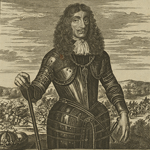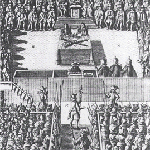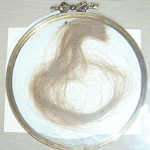|
 |
E210 | Casuistry, Conduct & Clarissa | Fall 2013
Casuistry, dependent on a complex understanding of conscience, is a case-based method of solving particular moral problems in light of known moral principles. The problem to be solved, known as a “case of conscience,” can range from whether to take an oath (when the stakes were very high), to whether it’s ok to buy something you think may be stolen, to whether a father can command a child to marry. Although there are some well-known casuistic texts (see, to the left, Sanderson’s 9 cases [posthumously published 1685] which as we will see can seem like fictional pre-texts, casuistry itself produces not a text but a process and thus a “habit of mind” and potentially a route into the mind. Like casuistry guides and compilations, conduct books such William Fleetwood’s The relative duties of parents and children, husbands and wives, masters and servants, consider’d in sixteen sermons: with three more upon the case of self-murther (1705), were guides to appropriate conduct and were akin to an ancient literature of duties, principally Cicero’s De Officiis. Conduct books set out to mold behavior, but they are only steps away from misbehavior. There is a huge bibliography on the relation between novels and conduct books, but we will move our questions back to an examination of the mind making decisions. Clarissa’s “life” is constructed of one case of conscience after another. |
 |
E102B | Dilemmas, political, religious, spiritual, moral: 1649-1725 | Spring 2009
This course is about political, religious, spiritual, and moral problems and the methods used to solve them by men and women in the 17th & 18th-centuries. We will start with political philosophy (reading selections of Thomas Hobbes’s Leviathan) and ask about the source of political authority and the method of creating political stability. The readings will then include a long satiric poem (John Dryden’s Absalom & Achitophel) that was supposed to have an influence on an immediate political crisis. The same crisis accounts for our next work (John Locke’s Two Treatises), which was written for the opposing side. Then we will read John Bunyan’s The Pilgrim’s Progress, a spiritual allegory in which a Christian soul has to turn his back on the corruption of the world and follow a solitary path to salvation. In a different mode and from a very different point of view, Mary Astell wrote Reflections on Marriage, which is both a feminist essay and a political pamphlet. The last work will be Daniel Defoe’s novel Roxana, about an energetic and clever woman whose strategies for survival often include methods that she recognizes as immoral. All these writers give us a sense of the struggle involved in dealing with the dilemmas of their period. |
 |
E210 | Divided Interests: dismembering and re-membering the "body politic" in the culture of the Restoration | Winter 2009
The famous illustration for Thomas Hobbes’s The Leviathan conveys the kinds and degrees of institutional and imaginative power necessary to maintain the “body politic.” And for Hobbes, England’s civil war[s] provided the images of disorder that constituted the ‘state of nature.’ We see throughout the Restoration and the years immediately following the turn of the century innumerable efforts to re-create a uniform polity. Those efforts were sometimes characterized by a desire for “comprehension” and a willingness to tolerate differing practices. But those efforts were sometimes dominated by the strategy of suppressing non-conformity, disabling dissent, disallowing exceptionality, an effort to force the recreation of a unitary society. The thesis of this course is that this is the period in which divided and competing interests were institutionalized—through official toleration of dissent, through the advance of sometimes very scrappy political partisanship, and through the growth of equity as a means of recognizing married women’s separate property. |
 |
E102B
| Restoration and Revolution: 1660-1700 | Winter 2008
This course
is in part framed by political events. We begin
in 1660--with the restoration of the monarchy after civil
war, the beheading of a king (Charles I), and several years
of Puritan dominance-- and end just after 1700, approximately
a decade after what became known as the "Glorious Revolution."
We will read drama--both aggressive wit comedy and heroic
tragedy-- satiric poetry, fiction, and feminist and political
essays. Lectures will also provide material from scientific
reports and from contemporary philosophy. Our material
invites us to ask questions about literary form, political
structures and principles, marriage, property, and the
status of women. And it invites us to consider fundamental
contrasts in a period marked both by restoration and by revolution.
|
 |
E199
| Austen | Winter 2008
In describing her own method as
a novelist, Austen wrote that she worked on a “little bit (two
inches wide) of ivory . . . with so fine a brush as produces
little effect after much labour.” Sir Walter Scott commented
that although he could do “the big Bow-Wow strain” of novels
very well, Austen had an “exquisite touch which renders ordinary
common-place things and characters interesting.” Modern
critics have written variously of her “regulated hatred,” her
conservative propaganda, and her view of social conventions
as fictions. In this E199, we will read four of Austen’s
six completed novels, biographical material on Austen; historical
material on the period; and numerous critical works. We
will consider many views of her work and ask questions about
her novelistic practice and about the social problems that her
novels engage. |
 |
Humanities
Core Course | Fall 2007, 2008, 2009
The Humanities Core Course builds first-year writing directly
into the introductory study of literature, history, and philosophy.
The course is organized thematically rather than chronologically,
and every three years, the themes change. The theme of this
cycle is THINKING | MAKING | DOING, key
building blocks of human activity.
In the Fall, we will consider THINKING and examine, evaluate,
and exercise different forms of argumentation and reasoning.
We will read major works of philosophy and rhetoric by Aristotle
and Descartes and will look at everyday acts of reasoning and
judgment and their representation in novels by Jane Austen and
Toni Morrison. |
|
Ann
Van Sant | University of California, Irvine | ajvansan@uci.edu
| ©2008 |

